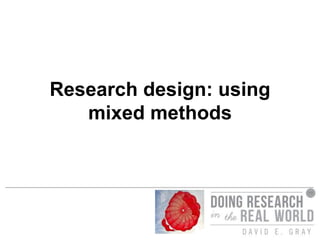
Chapter_8_Research_designs_using_mixed_m.ppt
- 1. Research design: using mixed methods
- 2. Objectives After this session you will be able to: • Distinguish between quantitative, qualitative and mixed research designs • Identify when qualitative and qualitative approaches can complement each other • Select from a range of mixed methods designs • Explain when mixed methods designs may not be appropriate
- 3. Definition Mixed methods consists of ‘the collection or analysis of both quantitative and qualitative data in a single study in which the data are collected concurrently or sequentially, are given a priority, and involve the integration of data at one or more stages in the process of research’ (Creswell et al, 2003: 212).
- 4. Differences between quantitative and qualitative methods Quantitative methods Qualitative methods Epistemological positions Objectivist Constructivist Relationship between researcher and subject Distant /outsider Close/insider Research focus ‘Facts’ Meanings Relationship between theory/concepts and research Deduction/confirmation Induction/emergent Scope of findings Nomothetic Ideographic The nature of data Data based upon numbers Data based upon text
- 5. Epistemological positions • Quantitative research emanates from an objectivist position which holds that reality exists independently of the researcher – the truth is ‘out there’. • Qualitative research is more closely linked to a constructivist paradigm, which sees truth and meaning as constructed and interpreted by individuals.
- 6. Relationship between researcher and subjects • Quantitative research, researchers aim to keep themselves at a distance (emotional/physical) from those they are researching • Qualitative research usually involves direct contact between researcher and those they are researching, sometimes for long periods of time.
- 7. Research focus • Quantitative research concentrates on the gathering of ‘facts’, in order that ‘truth claims’ can be established. • Qualitative researchers contend that truth and meaning do not exist in some external world, but are constructed through peoples’ interactions with the world
- 8. Scope of findings • Quantitative methods are regarded as nomothetic which attempts to establish law-like findings that hold irrespective of time • Qualitative research is ideographic which locates its findings in specific time periods and localities and is much more concerned with the depth and intensity of findings rather than breadth (generalizability)
- 9. The nature of data • Quantitative studies generate data in the form of numbers, often depicted positively as reliable and rigorous, probably because of their association with ‘science’. • Qualitative research generates what is claimed to be ‘rich’ or ‘deep’ data, usually in the form of text but sometimes in photographs, maps or other visual media.
- 10. Mixed methods allow researchers to…. • Generalise from a sample to a population (as in quantitative research) • Gain a richer, contextual understanding of the phenomenon being researched (as in qualitative research)
- 11. How methods can be mixed Types of mixing Comments Two types of research question One fitting a quantitative approach and the other qualitative The manner in which the research questions are developed Preplanned (quantitative) versus participatory/emergent (qualitative) Two types of sampling procedure Probability versus purposive Two types of data collection procedures Surveys (quantitative) versus focus groups (qualitative) Two types of data analysis Numerical versus textual (or visual) Two types of data analysis Statistical versus thematic Two types of conclusions Objective versus subjective interpretations
- 12. Mixed methods models DESIGN 1 DESIGN 2 DESIGN 3 QUAL Exploration QUANT Questionnaire QUAL Deepening and assessing results Continuous collection of both sorts of data QUAL QUANT QUANT Survey QUAL Field study QUANT Experiment
- 13. Qualitative then quantitative • Little is known about the research problem or research setting • Qualitative study explores, identifies and can provide clarity about the kinds of variables requiring further investigation.
- 14. Quantitative then qualitative • Quantitative study could be used to identify important themes that qualitative fieldwork could then deepen • Quantitative survey is used to identify groups of respondents with strongly contrasting views about a subject. These polarised groups can then be used for follow up qualitative interviews to gain an in-depth understanding
- 15. Quantitative and qualitative concurrently • Continuous collection of both sorts of data • The quantitative and qualitative data may focus on similar themes or on different themes
- 16. Benefits of mixed methods designs • Triangulation. Seeks convergence, corroboration, correspondence of results from different methods • Complementarity. Seeks elaboration, enhancement, illustration, clarification of results of one method with the results from the other • Development. Seeks to use the results of one method to help or inform the other method • Initiation. Seeks the discovery of paradox and contradiction, new perspectives, the recasting of questions or the results from one method with questions or results from the other method • Expansion. Seeks to extend the breadth and range of inquiry by using different methods from different inquiry components
- 17. Potential weaknesses of mixed methods • Quantitative questions may end up measuring different constructs to qualitative • Costs can be high • Problems in managing to synthesise quantitative and qualitative findings • Lack of integration in many studies
- 18. Summary • Quantitative and qualitative research methods have traditionally been associated with conflicting research paradigms based upon different epistemological positions • Many researchers now recognize that quantitative and qualitative approaches can be combined into a mixed methods design • Mixed methods approaches – can be based upon different types of research question, sampling procedures, data collection methods or approaches to data analysis – are flexible and can include sequential designs with quantitative methods preceding qualitative, or vice versa, or concurrent designs – should be based upon the kinds of questions being addressed and how the design can aid in the answering of these questions